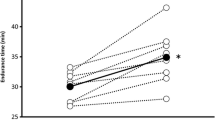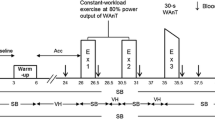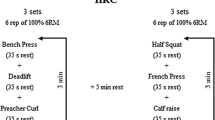Abstract
A group of 15 competitive male cyclists [mean peak oxygen uptake, V˙O2peak 68.5 (SEM 1.5 ml · kg−1 · min−1)] exercised on a cycle ergometer in a protocol which began at an intensity of 150 W and was increased by 25 W every 2 min until the subject was exhausted. Blood samples were taken from the radial artery at the end of each exercise intensity to determine the partial pressures of blood gases and oxyhaemoglobin saturation (S aO2), with all values corrected for rectal temperature. The S a O2 was also monitored continuously by ear oximetry. A significant decrease in the partial pressure of oxygen in arterial blood (P aO2) was seen at the first exercise intensity (150 W, about 40% V˙O2peak). A further significant decrease in P aO2 occurred at 200 W, whereafter it remained stable but still significantly below the values at rest, with the lowest value being measured at 350 W [87.0 (SEM 1.9) mmHg]. The partial pressure of carbon dioxide in arterial blood (P aCO2) was unchanged up to an exercise intensity of 250 W whereafter it exhibited a significant downward trend to reach its lowest value at an exercise intensity of 375 W [34.5 (SEM 0.5) mmHg]. During both the first (150 W) and final exercise intensities (V˙O2peak) P aO2 was correlated significantly with both partial pressure of oxygen in alveolar gas (P AO2, r = 0.81 and r = 0.70, respectively) and alveolar-arterial difference in oxygen partial pressure (P A−aO2, r = 0.63 and r = 0.86, respectively) but not with P aCO2. At V˙O2peak P aO2 was significantly correlated with the ventilatory equivalents for both oxygen uptake and carbon dioxide output (r = 0.58 and r = 0.53, respectively). When both P AO2 and P A−aO2 were combined in a multiple linear regression model, at least 95% of the variance in P aO2 could be explained at both 150 W and V˙O2peak. A significant downward trend in S aO2 was seen with increasing exercise intensity with the lowest value at 375 W [94.6 (SEM 0.3)%]. Oximetry estimates of S aO2 were significantly higher than blood measurements at all times throughout exercise and no significant decrease from rest was seen until 350 W. The significant correlations between P aO2 and P AO2 with the first exercise intensity and at V˙O2peak led to the conclusion that inadequatehyperventilation is a major contributor to exercise-induced hypoxaemia.
Similar content being viewed by others
Author information
Authors and Affiliations
Additional information
Accepted: 11 September 1998
Rights and permissions
About this article
Cite this article
Rice, A., Scroop, G., Gore, C. et al. Exercise-induced hypoxaemia in highly trained cyclists at 40% peak oxygen uptake. Eur J Appl Physiol 79, 353–359 (1999). https://doi.org/10.1007/s004210050520
Issue Date:
DOI: https://doi.org/10.1007/s004210050520




